The tomato frog is a large red amphibian from the island of Madagascar.
Madagascar’s exotic climate is the perfect home for many frogs. This island is home to species such as the Golden, Madagascan and blue-legged mantella.
They are popular for their bright colors, speckled appearance and docile personality.
Females are bright red and orange in color. Males are a bright yellow-orange.
In this guide we explain everything you need to know before buying this frog…
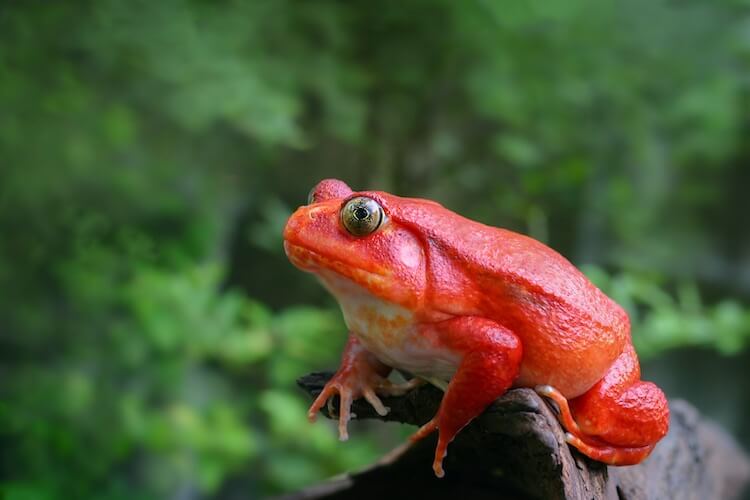
Tomato Frog Overview
The tomato frog was first discovered in the late 1800s on the island of Madagascar.
Since their discovery another two species were found within five years from 1872 to 1877. All three species are from the rainforests of Madagascar.
There are three known species of tomato frog:
- Dycophus antongili (Tomato Frog)
- Dyscophus guineti (Sambava Frog)
- Dyscophus insularis (Antsouhy Frog)
The most popular pet species is the Dycophus antongili. But, the tomato species did not become a popular pet frog until they were listed as endangered in the 1990.
In an attempt to save the species researchers began breeding them in captivity. During this time they quickly became popular with reptile enthusiasts.
Many keepers love the bright and vibrant color of this frog.
Tomato frogs come in warm shades of red, orange and yellow. They often have black speckles and brown stripes running down their body.
Keepers also enjoy their sedentary lifestyle and docile nature.
This frog does not move frequently and is nocturnal. During the day they burrow underground and during the night they hunt.
Are Tomato Frogs Good Pets?
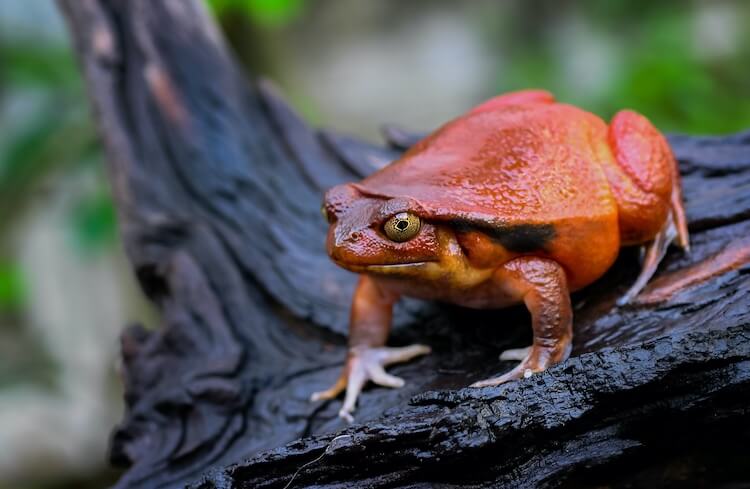
Tomato frogs make great pets. They are very docile and do not need a large enclosure. This makes them well suited to beginners.
This species spends most of its day burrowed in substrate. They also have a simple care and husbandry routine.
At night your frog will move around their terrarium, use ambush hunting tactics and vocalize.
Pros
- Vibrant shades of red, orange and yellow.
- Can keep multiple individuals in a single tank.
- Calm and docile nature.
Cons
- Should not be handled.
- Secrete toxic mucus when threatened or stressed.
- Cannot be kept with other species of frogs.
Species Appearance
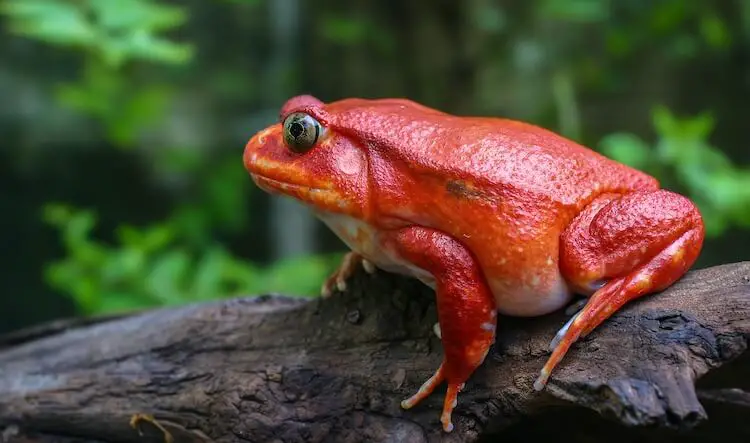
There are three species of tomato frog that are all part of the Dyscophinae family:
- Dycophus antongili (Tomato Frog)
- Dyscophus guineti (Sambava Frog)
- Dyscophus insularis (Antsouhy Frog)
Each species is from Madagascar but has a different appearance.
The Dycophus antongilii subspecies is more commonly known as the Tomato frog. This individual is the most popular pet species and is a vibrant red. They are found in the northeast area of Madagascar and can grow to four inches in size.
Females are easily identified by their bright red and orange colors. Males have a yellow-orange color.
Both sexes have a dark brown stripe running from behind the eyes to each back leg.
Occasionally they will have black spots speckled across their backs. Despite their backs being brightly colored their undersides are a muted off-white color.
The Dyscophus guineti subspecies is also known as the Sambava False Tomato Frog.
Sambava frogs are a burnt orange color. They are not as vibrantly colored and have a more muted appearance. They are found in moist tropical lowland forests or marshes on the east side of Madagascar.
The final species is the Dyscophus insularis; they are commonly known as the Antsouhy species and have a similar appearance to the Sambava species.
This species is found in dry tropical forests and savannas on the west side of Madagascar.
| Common Name | Appearance | Size | Location |
|---|---|---|---|
| Tomato Frog | Bright red and orange colors | 4 inches | Northeast area of Madagascar |
| Sambava False | A burnt orange color | 3.5 inches | East side of Madagascar |
| Antsouhy | Burnt orange | 3.5 inches | West side of Madagascar |
Tomato Frog Size
Males measure 2.5 to 3.5 inches when fully grown. Females are much larger in size and measure four inches.
Females are also heavier and can weigh up to half a pound.
Tomato frogs hatch from eggs as tadpoles. After two months these tadpoles will undergo metamorphosis into adults:
- Tadpole (0-2 months): 1/4 inch.
- Juvenile (2-24 months): 1 to 1.5 inches.
- Adult (24 months+): 2.5 to 4 inches.
Tomato Frog Care Sheet
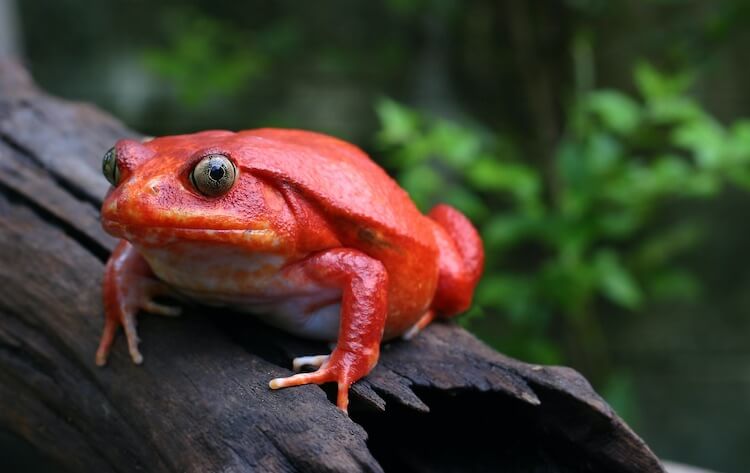
Tomato Frog Diet
In the wild tomato frogs are carnivores.
It is common for them to hunt a variety of insects such as worms, snails and burrowing insects.
They are nocturnal ambush hunters, so they do most of their eating at night-time. These frogs wait patiently for prey to stumble upon their hiding spot before attacking.
Even for a frog they are big eaters.
In captivity, they should be fed crickets, mealworms, waxworms, and superworms. Adults can occasionally be fed a small pinkie mouse:
- Adults should be fed six to ten prey items every other day.
- Juveniles should be fed four to five prey items every day.
Make sure to provide a variety of insects and not just one. You should also dust prey with a reptile calcium supplement (once a week for adults and three times a week for juveniles).
You will never see a Tomato frog drink water. But, this does not mean they do not need water.
Frogs, like all amphibians, absorb water through their skin.
You should fill a shallow dish with clean dechlorinated water that has a neutral pH level.
How Long Do Tomato Frogs Live?
Tomato frogs can live for up to eight years in captivity.
In order to reach eight years old they must be provided with the right diet (including supplements), have routine husbandry and not be stressed.
In order to maintain good health tomato frogs need calcium supplements.
Calcium supplements will ensure your frog receives nutrients their diet may not cover.
Another way to help keep your frog healthy is to reduce his stress. This species can suffer from predator-prey stress if housed with other frogs. For this reason it is best to house them alone or with the same species that is the same size and age.
Finally, you should also not attempt to handle this frog.
As amphibians they can absorb chemicals and substances through their skin. By handling your frog you can expose them to toxins found on your skin.
The following is a list of signs they are healthy:
- Vibrant and bright color.
- Not secreting toxic mucus.
- Clear eyes that are not cloudy.
Tomato Frog Habitat
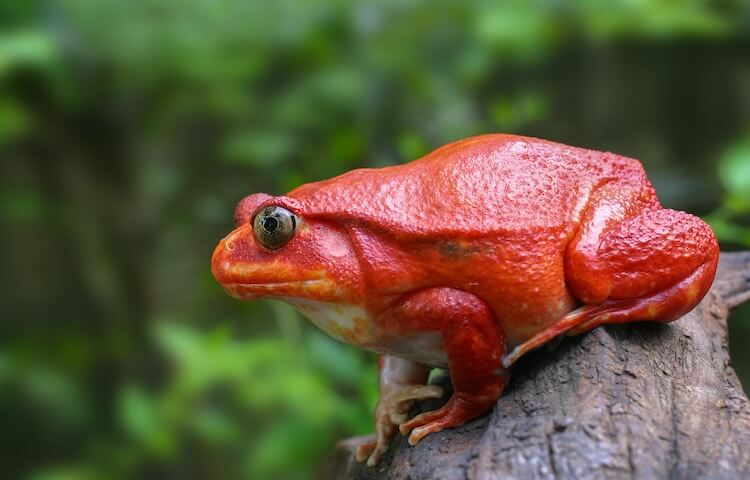
This species is normally found in the rainforests, swamps and marshes of Madagascar. They need the island’s tropical ecosystem and subtropical climate.
A tomato frog setup is very simple. This is one of the reasons why they are great for beginners.
They can be housed in a 10-gallon tank but ideally use a 20-gallon long tank. Make sure the tank has plenty of horizontal space and not vertical.
As a species that does not swim you can fill the entire tank with three inches of substrate.
The best substrate is coconut fiber. It is soft and will make burrowing easy for your frog. Add branches and hollow logs for decoration too.
If you want a planted tank it is possible to add live plants because of the coconut fiber substrate. However, the burrowing behavior of this frog will likely kill the plants. It is best to use fake plants!
Set Up Tips
- Tank Type: glass.
- Tank Size: 20-gallon long tank.
- Lighting: low wattage 2.0 UVB/UVA light.
- Substrate: three inches coconut fiber.
They are nocturnal and prefer to burrow under leaves and mud during the day.
Because of their nocturnal lifestyle they do not need any specific lighting.
If you are growing plants in their tank then use a low-wattage 2.0 UVB/UVA bulb.
The tank temperature should be kept between 65 to 85° Fahrenheit.
Humidity should be fairly high and kept between 65 to 80%. This is one of the reasons it is important to use a substrate like coconut fiber. It will help to keep the humidity high.
Make sure you mist the enclosure daily and do not forget to use a hygrometer.
Behavior
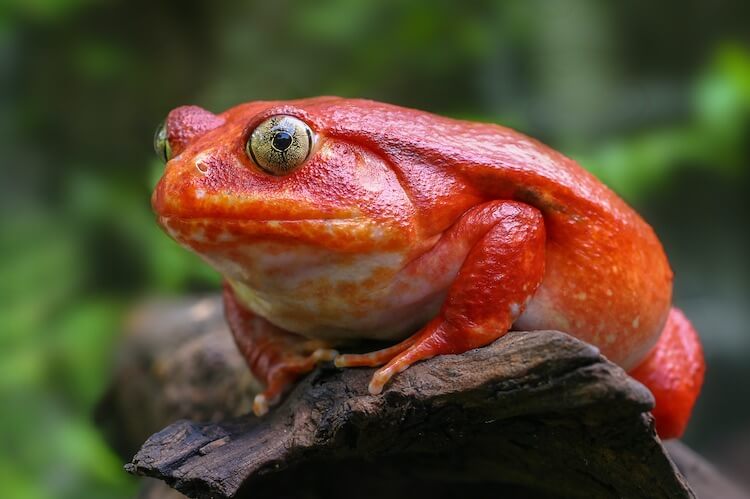
Tomato frogs have a docile and calm personality. They are also not very territorial. Because of this it is possible to house multiple individuals in the same tank.
However, they are known to cannibalize juveniles and smaller frogs.
For this reason you should only house individuals that are a similar same age and size.
When this frog senses danger they can react with two different behaviors:
- They can secrete a white mucous-like toxin through their skin.
- They can also inflate themselves to appear bigger. This is a common behavior in many animals.
In the wild males are very vocal at night time. They use loud calls as a way to attract mates.
Tomato frogs kept as pets will be largely inactive during the day. It is normal to find them burrowing and resting.
In captivity it is not uncommon for them to hide for long periods of time before ambushing their prey.
They are most active at night when they will hunt and vocalize.
Are Tomato Frogs Poisonous?
Tomato frogs secrete a white, sticky, toxic substance when stressed or threatened. It is not uncommon for them to secrete this toxic substance when being handled.
Interestingly this trait is not unique to just tomato frogs. Many amphibians from Madagascar also share this defense mechanism.
Owners should not attempt to handle this frog.
Tomato frogs should not be handled unless it is necessary to do so (e.g. cleaning their enclosure and health checkups).
If you need to handle them, then wash your hands carefully before and after you touch them.
If you handle this species for too long they will feel stressed and become irritated. At this point they will begin to secrete a white toxin from their skin.
Buying A Tomato Frog
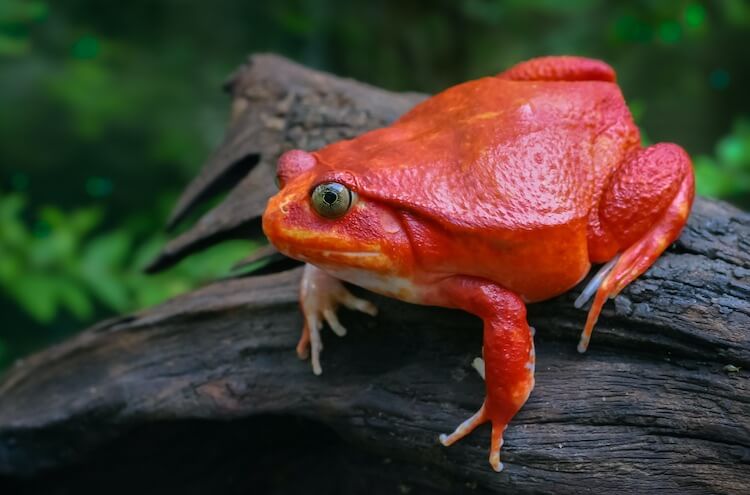
It is common for beginners to purchase this species after the tadpole stage of development.
Most are bought at around two months of age.
Tomato frogs can be purchased for between $20 and $50. Private breeders will charge closer to $50.
Juveniles and adults are very easy to find. They are a very popular amphibian and can be found in many pet stores.
When purchasing a frog make sure you check his health.
You can quickly gauge how healthy they are based on their physical appearance. Healthy tomato frogs will be very bright and vibrant in color, demonstrate a full range of motion, and are plump.
After buying them you will also need to budget for their habitat setup. It can cost anywhere from $100 to $500 for a tank, decorations, substrate, heating lamp and diet.
Tomato Frog Facts
| Common Name | Tomato Frog |
|---|---|
| Scientific Name | Dycophus antongilii, Dyscophus guineti, Dyscophus insularis |
| Price | $20 to $50 |
| Size | 2.4 to 4 inches long |
| Lifespan | 6 to 8 years |
| Diet | Insects (crickets, mealworms, etc) |
| Humidity & Temperature | Daytime temperature: 65℉ to 85℉ Nighttime temperature: 70℉ to 75℉ Humidity: 70% to 80% |
| Popular Alternatives | White’s Tree Frog, Bumble Bee Frog, Burmese Chubby Frog |
Summary
The tomato frog is one of three species in the dyscophinae family. They were first discovered in the 19th century in the rainforests of Madagascar.
This species is a beautiful bright red-orange and has black speckles on their back.
They are docile, calm and low maintenance. Providing them with a big tank filled with substrate is very simple.
If you are a first time keeper, and want to bring home a colorful frog, then look no further.
They are a great beginner frog, especially for keepers who are not interested in handling.
If you have kept this colorful amphibian before then be sure to share your tips in the comment section.

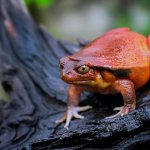
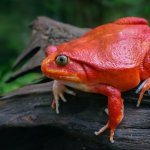
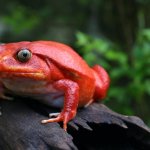
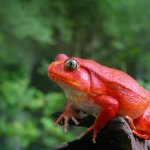
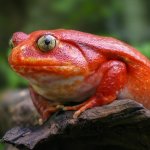
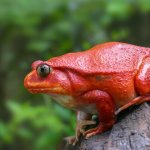

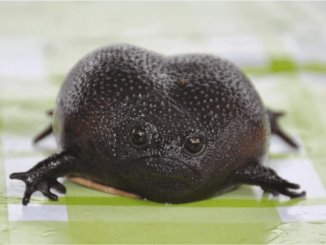
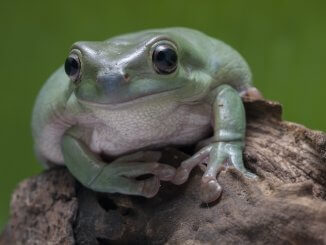
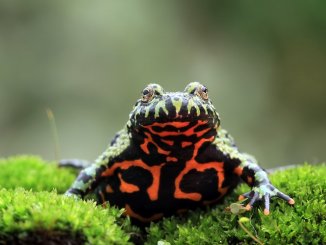

Frigs like bugs. Give frogle bugle on daily basses.